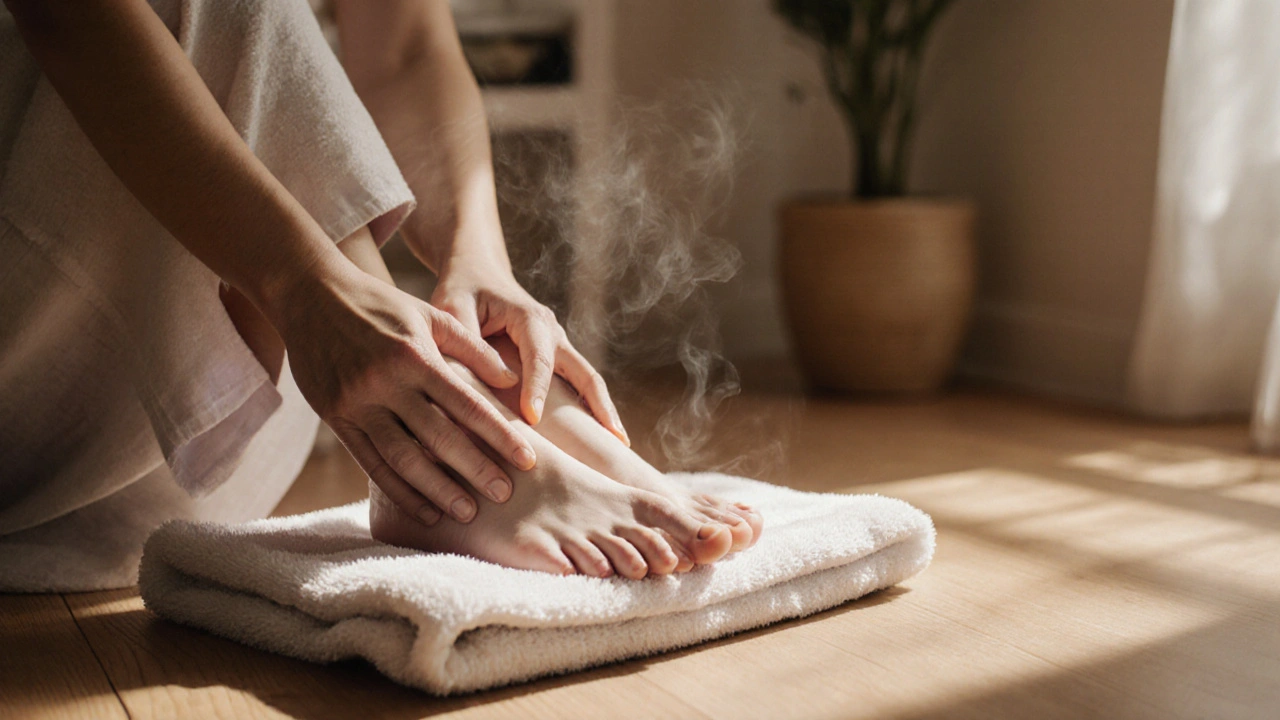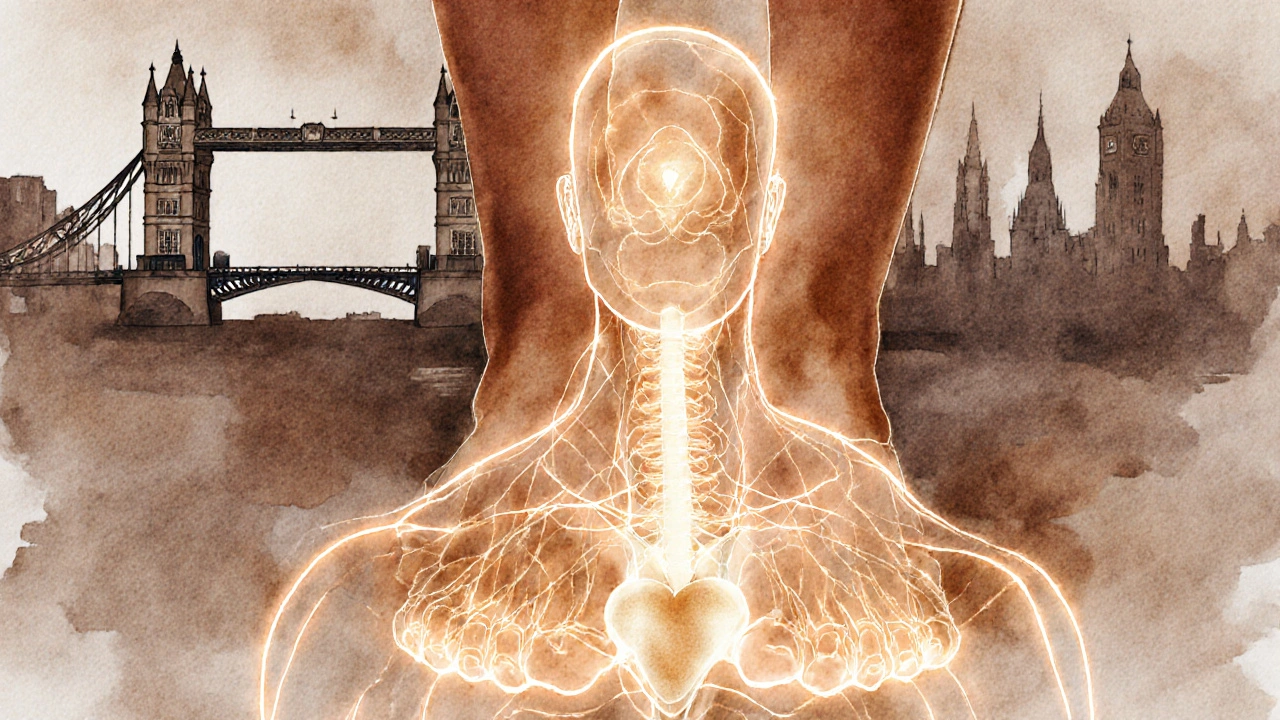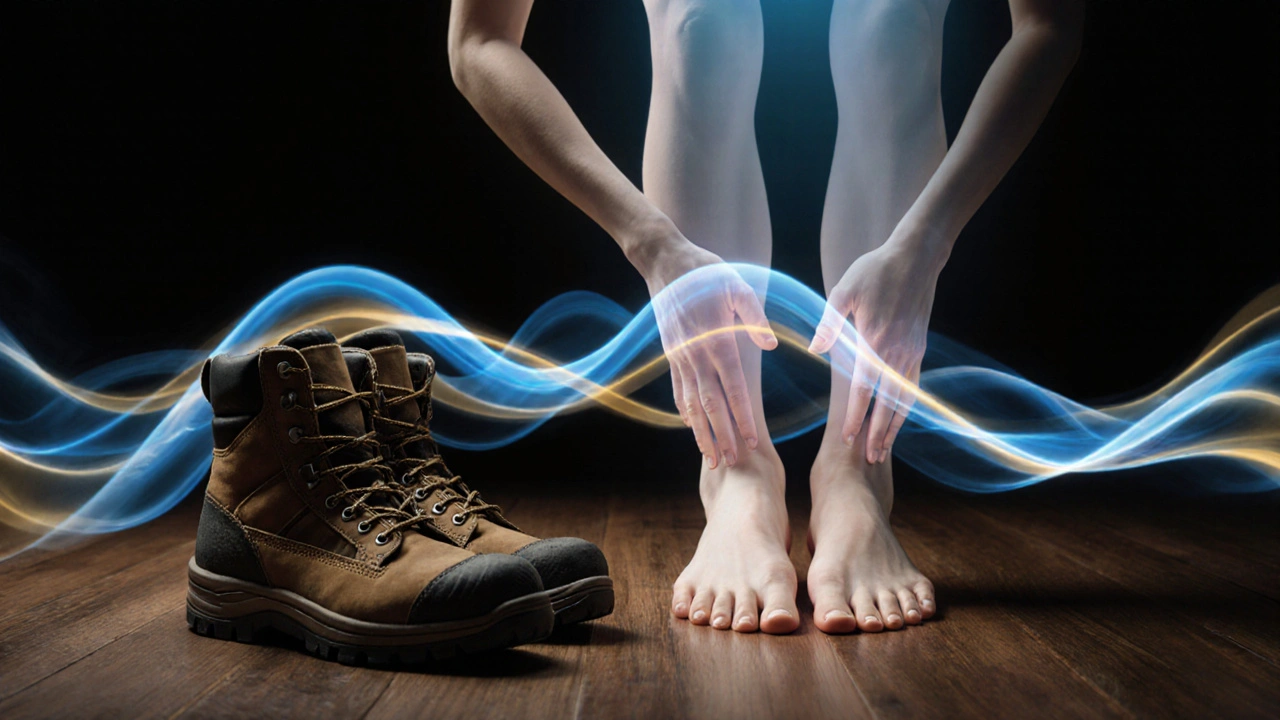Discover how foot massage reduces stress, relieves pain, and improves sleep. Learn the best types in London, pricing, safety tips, and why this simple therapy works wonders for your whole body.

- Created by: Archer Caldwell
- Completed on: 17 Nov 2025
- Categories: Foot Massage
You’ve probably stood all day at work, shuffled through crowded streets, or worn shoes that felt more like torture devices than footwear. By the time you get home, your feet are screaming. But what if the solution isn’t just a new pair of sneakers-it’s something simpler, older, and surprisingly powerful? A foot massage.
It’s not just a luxury. It’s a reset button for your whole body. And if you’re in London, you’re never far from someone who knows how to do it right.
Why Your Feet Deserve More Than a Quick Rub
Your feet carry you. Every step, every sprint, every late-night walk home-they take the hit. And yet, most of us barely notice them until they hurt. That’s the problem. We treat our feet like afterthoughts.
A foot massage doesn’t just soothe sore arches. It triggers a chain reaction. The soles of your feet are packed with nerve endings-over 7,000 of them. When pressure is applied, those nerves send signals straight to your brain that say: “Relax. You’re safe.” It’s like hitting pause on your nervous system.
Studies show that even a 10-minute foot massage can lower cortisol levels-the main stress hormone. One 2021 trial at a London hospital found patients who received daily foot massages before surgery reported 37% less anxiety than those who didn’t. No pills. No waiting. Just hands on feet.
What Exactly Is a Foot Massage?
A foot massage isn’t just rubbing your soles. It’s a targeted technique that works on muscles, tendons, ligaments, and pressure points. In traditional Chinese medicine, it’s called reflexology-the idea that specific spots on your feet connect to organs and systems elsewhere in your body. Press the ball of your foot, and you might be stimulating your lungs. Rub behind your heel, and you could be easing tension in your lower back.
Modern foot massage blends that with Swedish strokes, deep tissue work, and sometimes heat or oils. It’s not magic, but it’s science-backed. The pressure increases blood flow, reduces muscle stiffness, and helps flush out lactic acid and other waste products that build up after long days on your feet.
In London, you’ll find everything from quick 15-minute sessions at train station kiosks to hour-long spa treatments with Himalayan salt scrubs and aromatherapy. But the core is the same: hands working your feet to bring calm to your whole body.
The Real Benefits You Can Feel Today
Let’s cut through the fluff. Here’s what actually happens when you make foot massage part of your routine:
- Reduces swelling - Standing all day? Your ankles puff up. A good massage encourages lymphatic drainage, helping fluid move out of your lower limbs.
- Improves sleep - A 2020 study in the Journal of Alternative and Complementary Medicine found that people who got weekly foot massages fell asleep faster and stayed asleep longer. Why? Lower stress + better circulation = deeper rest.
- Alleviates plantar fasciitis - That sharp heel pain? Often caused by tight connective tissue. Regular massage loosens it up. Many physiotherapists in London now recommend it as a first-line treatment.
- Boosts circulation - Cold feet? Poor blood flow. Massage opens up capillaries, bringing warmth and oxygen to tired tissues.
- Relieves tension headaches - Believe it or not, tightness in your feet can echo up to your neck and skull. Massaging the inner edge of your foot (linked to the sinuses) can ease pressure behind the eyes.
One London office worker, Sarah, told me she started getting foot massages twice a month after chronic migraines got worse. Within three weeks, her headaches dropped from five days a week to one. She didn’t change her diet, her screen time, or her meds. Just added foot massage. “It’s like my body finally got the memo to chill out.”
Types of Foot Massage Available in London
Not all foot massages are the same. Here’s what you’ll find around the city:
- Reflexology - Focused on pressure points tied to organs. Best for stress, digestion, or hormonal balance. Popular in holistic centres like Camden and Islington.
- Swedish Foot Massage - Gentle, flowing strokes. Ideal for relaxation and circulation. Found in most day spas across Chelsea and Notting Hill.
- Deep Tissue Foot Massage - Targets knots and chronic tightness. Great for runners, nurses, or anyone on their feet all day. Look for therapists trained in sports recovery.
- Thai Foot Massage - Uses sticks, ropes, and acupressure. More intense. Often includes stretching. Try it at Thai wellness studios in Soho or Brixton.
- Hot Stone Foot Massage - Warm basalt stones melt into your arches. Adds deep warmth and muscle release. Perfect for winter months.
Most places offer 30, 45, or 60-minute sessions. If you’re new, start with 30 minutes. You don’t need to go all-in right away.

How to Find a Good Foot Massage in London
You don’t need to book a five-star spa to get real results. Here’s how to find quality without overspending:
- Check reviews on Google or Trustpilot - Look for mentions of “pain relief,” “relaxing,” or “professional.” Avoid places with no recent reviews.
- Ask your physio or GP - Many recommend licensed massage therapists who work with chronic pain patients.
- Try a mobile therapist - Services like London Foot Relief or Relax at Home come to you. Great if you’re tired, pregnant, or just hate commuting after work.
- Look for certified therapists - Check for qualifications from the Complementary and Natural Healthcare Council (CNHC) or General Council for Massage Therapists (GCMT).
- Start with a trial session - Many places offer £15-£20 intro deals. Test the pressure, the cleanliness, and the vibe before committing.
Pro tip: Book after work, not before. You’ll feel the relief longer if you’re already in relaxation mode.
What to Expect During a Session
Picture this: You sit in a quiet room with soft lighting. The scent of lavender lingers. Your shoes come off. Your feet are washed with warm water and maybe a bit of sea salt. Then-hands begin to work.
At first, it might feel strange. Some spots will ache. That’s normal. A good therapist will ask you to rate the pressure: “Is this too much? Too little?” They’ll adjust. No one wants you to grit your teeth.
They’ll use oil or lotion to glide over your skin. Fingers press into your arches. Thumbs circle your heels. Sometimes they’ll gently pull your toes. You might feel a tingle, a warmth, or even a yawn. That’s your body releasing tension.
Most sessions last 30-60 minutes. You’ll leave feeling lighter. Not just in your feet-in your shoulders, your jaw, your mind.
Pricing and Booking
Costs vary depending on location, duration, and therapist experience:
- 15-minute express - £10-£15 (train stations, airports, high street kiosks)
- 30-minute standard - £25-£40 (local spas, wellness centres)
- 45-minute deep tissue - £45-£60 (specialist therapists)
- 60-minute luxury - £65-£90 (high-end spas like The Sanctuary in Mayfair or The Spa at The Langham)
Many places offer packages: buy five sessions, get one free. Some corporate wellness programs even cover foot massages as part of employee benefits. Ask your HR department.
Booking is easy. Most therapists use online calendars via platforms like Acuity or SimplyBook.me. You can also walk in-but you’ll pay more and wait longer.

Safety Tips
Foot massage is safe for almost everyone-but not if you ignore a few red flags:
- Don’t get one if you have open wounds, infections, or blood clots - Your feet are a gateway. If something’s broken there, don’t risk spreading it.
- Avoid deep pressure if you’re pregnant - Certain points on the foot can trigger contractions. Stick to gentle Swedish or reflexology.
- Tell your therapist about diabetes - Nerve damage can make you less sensitive to pain. They’ll need to go lighter.
- Hydrate after - Massage moves fluids. Drink water to help flush out toxins.
- Trust your gut - If someone makes you uncomfortable, leaves you alone too long, or doesn’t ask about your health, walk out.
Foot Massage vs. Foot Spa: What’s the Difference?
People often confuse foot massage with foot spas. Here’s the real difference:
| Feature | Foot Massage | Foot Spa |
|---|---|---|
| Primary Goal | Therapeutic relief, pain reduction, muscle release | Relaxation, pampering, aesthetic care |
| Technique | Manual pressure, reflexology, deep tissue | Soaking, scrubbing, paraffin wax, bubbles |
| Duration | 30-60 minutes | 20-45 minutes |
| Best For | Chronic pain, stress, circulation issues | Weekend treat, social outing, glowing skin |
| Therapist Training | Certified in anatomy, massage therapy | Often esthetician or salon staff |
| Cost (30 min) | £25-£40 | £30-£50 |
Want results? Go for massage. Want to feel like a VIP? Go for spa. You can even do both-massage first, then soak. But don’t mistake bubbles for healing.
Frequently Asked Questions
Can foot massage help with insomnia?
Yes. Foot massage activates the parasympathetic nervous system, which tells your body it’s time to rest. A 2020 study found participants who received weekly foot massages for four weeks reported falling asleep 30% faster and waking less often. The key is consistency-try it 2-3 times a week for best results.
Is foot massage safe during pregnancy?
Generally yes, but with caution. Avoid deep pressure on the inner ankle and ball of the foot-these areas are linked to uterine contractions in reflexology. Stick to gentle Swedish techniques and always inform your therapist you’re pregnant. Many London therapists specialize in prenatal care.
How often should I get a foot massage?
If you’re on your feet all day or deal with chronic pain, aim for once a week. For general stress relief or maintenance, once every two weeks is enough. Even monthly sessions can make a noticeable difference over time. Think of it like brushing your teeth-small, regular care prevents bigger problems.
Can I do a foot massage myself?
Absolutely. Roll a tennis ball under your arch for 2 minutes. Use your thumbs to press along the sole, starting from heel to toe. Try a warm foot soak with Epsom salts first-it softens tissue and boosts circulation. Self-massage won’t replace a professional, but it’s a powerful daily habit.
Do foot massages really help with headaches?
They can. The big toe is connected to the head and sinuses in reflexology. Applying firm, circular pressure there for 30 seconds can ease tension behind the eyes. Many Londoners with migraines report relief after targeted foot sessions, especially when combined with neck stretches.
Ready to Step Into Calm?
You don’t need a vacation to feel restored. Sometimes, all you need is 30 minutes, a pair of bare feet, and someone who knows how to listen with their hands.
Foot massage isn’t a trend. It’s a tradition that’s stood the test of time-and science. Whether you’re a nurse, a teacher, a parent, or just someone who’s had enough of aching soles, it’s time to give your feet the attention they’ve earned.
Book your first session this week. Your feet will thank you. And so will the rest of you.

Kayla Hochard
November 18, 2025 AT 08:46Oh wow, another article telling me to massage my feet like I’m some kind of hippie who drinks kombucha and meditates with crystals. Newsflash: I work 60 hours a week in a cube farm and my shoes are steel-toed. A 15-minute foot rub isn’t going to fix my chronic plantar fasciitis or the fact that my boss thinks ‘self-care’ means not quitting.
And don’t get me started on ‘reflexology’-that’s just pseudoscience dressed up in lavender oil. If your feet control your lungs, why don’t we just start stapling acupuncture needles to our toes and call it a day?
Also, London? Cool. I’m in Ohio. The closest thing I’ve got is a Walmart employee with a $10 massage chair and a nicotine habit. Thanks for the fluff, but I’ll stick to ibuprofen and screaming into my pillow.
Andre Estrela
November 18, 2025 AT 18:01Okay but imagine this 😭👇
Feet in warm water 🛁✨
Thumbs pressing into arches like they’re solving a mystery 🕵️♀️
Some dude in a silk robe whispering ‘breathe’ 🧘♂️
Then… a single tear rolls down your cheek because for the first time in 3 years… you feel… safe.
It’s not a massage. It’s therapy with socks off. 🥺👣 #FootMassageIsMyTherapy #LondonIsMagic
Kelsey Stratton
November 18, 2025 AT 18:39I do this every night with a tennis ball. Just roll it under your foot while watching TV. Feels good. No need to spend money.
My feet stop hurting after a week. Simple.
Sean Marcus
November 19, 2025 AT 03:26Foot massage? Bro. I just sit on the couch and wiggle my toes. That’s like… 80% of the benefit right there. Why pay $40 when you’ve got 10 toes and a couch? 🤷♂️
Also, ‘Himalayan salt scrubs’? That’s just sand with a fancy name. I scrub my feet with dish soap and call it a day. Save your cash for beer.
prajesh varma
November 20, 2025 AT 17:17Man, you folks are overthinking this like it’s rocket science. In my village in Kerala, we’ve been doing foot rubs since before your grandparents were born. No lavender, no spas, no CNHC certifications.
Just a warm oil, a strong hand, and a grandma who knows where the knots live. You think your ‘deep tissue’ is intense? Try a 70-year-old woman with calloused palms and zero patience for your ‘pressure preferences.’
And don’t even get me started on ‘reflexology’-we didn’t need charts to know that if your foot aches, you’ve been walking too much. Simple physics, not magic.
London’s got its fancy kiosks, but real healing? It’s not in a spa. It’s in the hands of someone who’s seen a thousand tired feet-and still cares enough to touch them.
So next time you’re thinking of booking a £90 session? Ask your auntie. She probably knows better.
Selene Becmar
November 21, 2025 AT 12:17There’s something profoundly metaphysical about the foot as a microcosm of the soul, isn’t there? 🌌
Every pressure point is a silent scream from the unconscious-a somatic echo of repressed grief, unspoken ambition, the quiet ache of modern alienation.
When the therapist’s thumb presses into the medial arch, they’re not just releasing fascia-they’re unlocking the buried narrative of your daily compromises. The 7,000 nerve endings? They’re not receptors. They’re oracles.
And yet, we reduce this sacred ritual to a ‘wellness trend’-as if the body were merely a machine to be serviced, not a temple whispering in the language of touch.
London’s spas are beautiful, yes, but they’re also performative. The real transformation happens when you stop seeking relief and start listening. When your feet stop being ‘problem areas’ and become your most honest confidants.
That’s why I wept during my third session. Not because it hurt. But because for the first time, I felt… seen.
Foot massage isn’t a treatment. It’s a reclamation.
🫂✨
Carli Lowry
November 22, 2025 AT 10:35Just got back from a Thai foot massage in Brixton and I’m still floating. 🌿
They used this wooden stick to press along my arches-felt like someone was untangling my spine from the inside. And the herbal steam? Like breathing in a temple in Chiang Mai.
But here’s the thing: I’ve been doing this for a year now. Every Tuesday. And honestly? It’s changed how I move through the world. I don’t clench my jaw as much. I walk slower. I notice things.
Also, the therapist asked if I was okay after I cried. No one’s ever done that before. Not my therapist. Not my partner. Just a stranger with oil-stained hands.
Don’t sleep on this. It’s not a luxury. It’s a lifeline.
And yes, I cried. So what? My feet deserve tears.
Enuma Eris
November 22, 2025 AT 16:22Foot massage? Yes. But don’t forget the rest of the body. You can’t heal one part while ignoring the whole.
My uncle in Lagos used to say: 'A tired foot is a symptom, not the disease.'
He was right. I’ve seen people spend hundreds on foot treatments while their back screams, their neck locks, and their breath stays shallow.
Massage is good. But posture? Breathing? Sleep? Those matter more.
Still, if your feet hurt-rub them. They’ve carried you this far. Don’t be cruel to the part that never asked for a break.
Simple. Human. True.